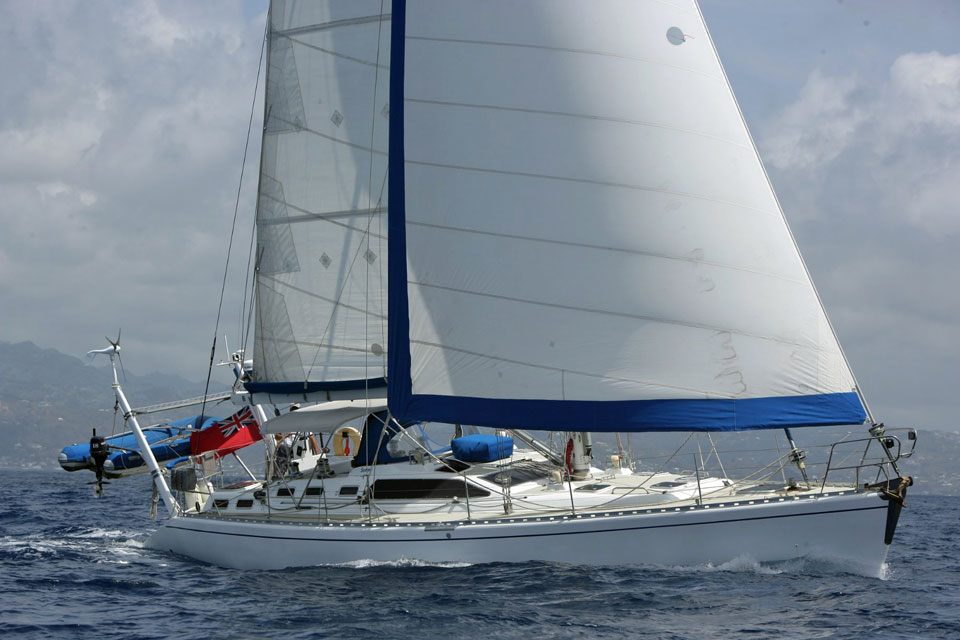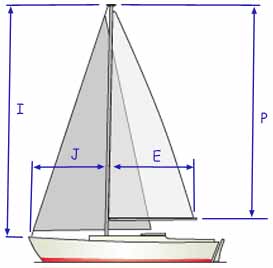- Home
- Sailboats 50'-55'
- Sovereign 51 Specs
The Sovereign 51
Specs & Key Performance Indicators
The Sovereign 51 sailboat, designed by South African naval architect Phil Southwell was constructed by Scholtz Marine, based in South Africa.
 A Sovereign 51 under full sail
A Sovereign 51 under full sailPublished Specification for the Sovereign 51
Keel & Rudder Configuration: Fin keel & spade rudder
Hull Material: Fiberglass
Length Overall: 15.5m (51'0")
Waterline Length: 13.3m (43'6")
Beam: 4.5m (14'8")
Draft: 1.9m (6'2")
Rig Type: Masthead sloop
Displacement: 14,424 kilograms (31,800 pounds)
Ballast: 5,590 kilograms (12,320 pounds)
Water Tank Capacity: 598 litres (158 gallons)
Fuel Tank Capacity: 397 litres (105 gallons)
Hull Speed: 8.84 knots
Designer: Phil Southwell
Builder: Scholtz Marine
Year First Built: 1995
Options & Alternatives
The Sovereign 51 sailboat offered several design options for buyers:
- Rig Type: Buyers could choose between different rig configurations, including masthead sloop and cutter rigs.
- Draft: There were options for both deep and shallow draft versions, allowing customization based on sailing preferences and intended cruising grounds.
- Interior Layouts: Various interior layouts were available to suit different needs and preferences, including options for the number of cabins, layout of the saloon, and galley configurations.
Sail Areas & Rig Dimensions
I: 18.29m (60'0")
J: 5.49m (18'0")
P: 16.76m (55'0")
E: 5.18m (17'0")
Published Design Ratios
The Key Performance Indicators (KPIs)
- Sail Area/Displacement Ratio (SA/D): 16.5
- Ballast/Displacement Ratio (B/D): 38.7%
- Displacement/Length Ratio (D/L): 172.4
- Comfort Ratio (CR): 29.8
- Capsize Screening Formula (CSF): 1.9
- The Sail Area/Displacement Ratio (SA/D) of 16.5 falls into the range indicating reasonably good performance. The boat will have adequate sail power to drive it efficiently and is expected to perform well, particularly in moderate wind conditions.
- With a Ballast/Displacement Ratio (B/D) of 38.7%, the Sovereign 51 appears to be on the higher end of moderate but just shy of being considered stiff and powerful (which would be 40% or above). It should still have good stability and the capability to stand up to the wind reasonably well.
- The Displacement/Length Ratio (D/L) of 172.4 places the Sovereign 51 in the Light Displacement category. This indicates that it will require less sail area to reach its hull speed, suggesting it is more likely to be a reasonably fast cruiser that is nimble and responsive under sail.
- With a Comfort Ratio (CR) of 29.8, the boat is expected to have a somewhat lively motion, typical of a coastal cruiser with moderate stability. It should be comfortable for extended cruising but may exhibit more motion compared to heavier bluewater cruisers, which can be noticed in rougher conditions at sea.
- A Capsize Screening Formula (CSF) of 1.9 is below the threshold of 2.0, indicating that the Sovereign 51 is considered suitable for bluewater sailing. This suggests that the boat has good beam-to-displacement characteristics, making it less likely to capsize and capable of handling offshore conditions effectively.
Summary: The Sovereign 51 is designed as a well-performing cruiser with sufficient sail power, good stability, and responsiveness under sail. It offers a moderate level of comfort suitable for extended cruising, while also being capable and safe for ocean passages, thanks to its favorable CSF. As a cruising sailboat, it provides a balanced mix of performance, comfort, and seaworthiness, suitable for sailors looking for versatility in a variety of sailing conditions.
Here's how to calculate the KPIs yourself - without having to wrestle with the mathematics...
Design Ratios: Notes of Caution...
- The Sail Area/Displacement Ratio (SA/D): This ratio provides an estimate of the sail power relative to the boat's weight, which can indicate potential speed in various wind conditions. But it doesn't account for the efficiency of the sail plan, the rigging, or the skill of the crew. Real-world performance can vary significantly based on these factors.
- The Ballast/Displacement Ratio (B/D): This ratio gives an idea of the boat's stability and stiffness, which is crucial for handling and safety. But it doesn't consider the distribution of the ballast or the hull shape, both of which can greatly affect stability. A high B/D ratio alone doesn't guarantee a stable boat if the ballast is poorly distributed.
- The Displacement/Length Ratio (D/L): This ratio helps predict the boat's speed potential and its behaviour in different sea conditions. But it doesn't account for the hull design or the boat's overall weight distribution. Two boats with the same D/L ratio can perform very differently if their hull shapes are different.
- The Comfort Ratio (CR): This ratio estimates the boat's motion comfort in a seaway, which is important for long passages. But it doesn't consider the boat's interior layout, which can also affect comfort. Additionally, personal tolerance to motion varies, so a boat that is comfortable for one person might not be for another.
- The Capsize Screening Formula (CSF): This formula assesses the likelihood of a boat capsizing in heavy seas, which is critical for offshore safety. But it doesn't take into account the boat's handling characteristics or the skill of the crew. A boat with a low CSF can still capsize if poorly handled in severe conditions.
General Limitations
- Static Nature: These ratios are static measurements and don't account for dynamic factors like wave action, wind gusts, or crew actions.
- Simplification: They simplify complex interactions into single numbers, which can be misleading. Real-world performance is influenced by a multitude of factors that these ratios can't fully capture.
- Context: The context in which the boat is used (e.g., coastal cruising vs. offshore racing) can greatly affect how these ratios should be interpreted.
In summary, while these ratios provide valuable insights into the theoretical performance characteristics of a sailboat, they should be used as part of a broader assessment that includes practical experience, sea trials, and expert advice.
This article was written with the assistance of Gemini, a large language model developed by Google. Gemini was used to gather information, summarize research findings, and provide suggestions for the content and structure of the article.
Recent Articles
-
Is Marine SSB Still Used?
Apr 15, 25 02:05 PM
You'll find the answer to this and other marine SSB-related questions right here... -
Is An SSB Marine Radio Installation Worth Having on Your Sailboat?
Apr 14, 25 02:31 PM
SSB marine radio is expensive to buy and install, but remains the bluewater sailors' favourite means of long-range communication, and here's why -
Correct VHF Radio Procedure: Your Questions Answered
Apr 14, 25 08:37 AM
Got a question about correct VHF radio procedure? Odds are you'll find your answer here...













